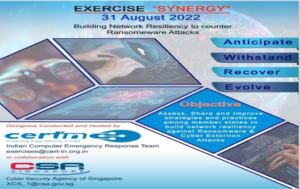In news– CERT-In under Ministry of Electronics & IT, in collaboration with Cyber Security Agency of Singapore (CSA), has successfully conducted the Cyber Security Exercise “Synergy”.
About the Exercise-
- It was conducted for 13 countries as part of the International Counter Ransomware Initiative- Resilience Working Group which is being led by India under the leadership of National Security Council Secretariat(NSCS).
- The theme of the exercise was “Building Network Resiliency to Counter Ransomware Attacks”.
- The exercise scenario was derived from real life cyber incidents, in which a domestic level (limited impact) ransomware incident escalates to a global cyber security crisis.
- Exercise “Synergy” was hosted by CERT-In on its exercise simulation platform.

- Each State participated as a National Crisis Management Team having composition from different government agencies including National CERTs/CSIRTs, Law Enforcement Agencies (LEA), Communication & IT/ICT Ministry and Security agencies.
- The specific objective of the exercise was to Assess, Share and Improve strategies and practices among Member-States to build network resiliency against ransomware & cyber extortion attacks.
What is Ransomware?
- Ransomware is a type of malicious software, or malware, that prevents you from accessing your computer files, systems, or networks and demands you pay a ransom for their return.
- Ransomware attacks can cause costly disruptions to operations and the loss of critical information and data.
Examples of Ransomware-
WannaCry:
- A powerful Microsoft exploit was leveraged to create a worldwide ransomware worm that infected over 250,000 systems before a kill switch was tripped to stop its spread.
CryptoLocker:
- This was one of the first of the current generation of ransomware that required cryptocurrency for payment (Bitcoin) and encrypted a user’s hard drive and attached network drives.
- Cryptolocker was spread via an email with an attachment that claimed to be FedEx and UPS tracking notifications.
NotPetya:
- Considered one of the most damaging ransomware attacks, NotPetya leveraged tactics from its namesake, Petya, such as infecting and encrypting the master boot record of a Microsoft Windows-based system.
- NotPetya leveraged the same vulnerability from WannaCry to spread rapidly, demanding payment in bitcoin to undo the changes.
- It has been classified by some as a wiper, since NotPetya cannot undo its changes to the master boot record and renders the target system unrecoverable.
Bad Rabbit:
- Considered a cousin of NotPetya and using similar code and exploits to spread, Bad Rabbit was a visible ransomware that appeared to target Russia and Ukraine, mostly impacting media companies there.
- Unlike NotPetya, Bad Rabbit did allow for decryption if the ransom was paid.
- The majority of cases indicate that it was spread via a fake Flash player update that can impact users via a drive by attack.
REvil:
- REvil is authored by a group of financially motivated attackers.
- It exfiltrated data before it encrypts it so that targeted victims can be blackmailed into paying if they choose not to send the ransom.
- The attack stemmed from compromised IT management software used to patch Windows and Mac infrastructure.
- Attackers compromised the Kaseya software used to inject the REvil ransomware onto corporate systems.
Ryuk:
- Ryuk is a manually distributed ransomware application mainly used in spear-phishing. Targets are carefully chosen using reconnaissance.
- Email messages are sent to chosen victims, and all files hosted on the infected system are then encr.
















